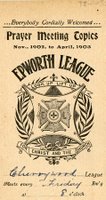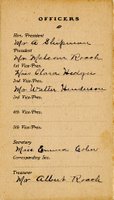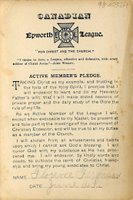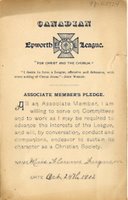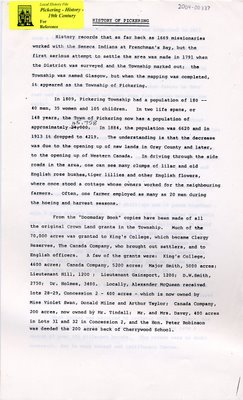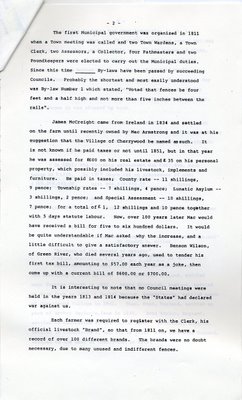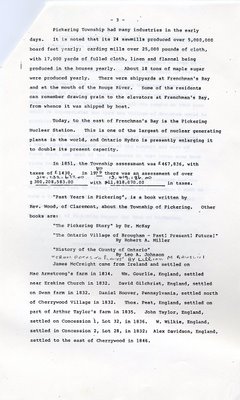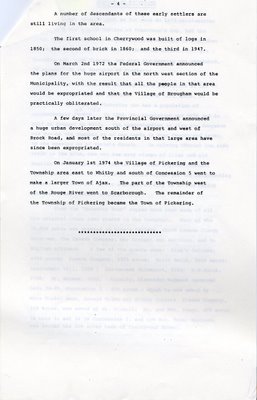Cherrywood, Ontario
. . . the Past and the Present.
Sunday, April 23, 2006
James McCreight - Cherrywood Founder
 —There died at his farm near Cherrywood, on Friday, the 19th. one of Pickering's oldest and most highly respected citizens, in the person of James McCreight, J.P. Deceased was rather of a retiring nature yet his good hard sense and clear foresight brought him forward and he was for many years an honored member of the municipal council both as reeve and subordinate. The name of James McCreight is inseperable with the earlier history of Pickering township. For the past few years he has lived a retired life, contenting himself with looking after the affairs of his farm. He was in his 82nd year. The bereaved widow and five daughters have much sympathy in their hour of trouble. The funeral took place Monday and was largely attended by old friends from various parts of the county. The remains were interred in Erskine cemetery, 2nd concession.
—There died at his farm near Cherrywood, on Friday, the 19th. one of Pickering's oldest and most highly respected citizens, in the person of James McCreight, J.P. Deceased was rather of a retiring nature yet his good hard sense and clear foresight brought him forward and he was for many years an honored member of the municipal council both as reeve and subordinate. The name of James McCreight is inseperable with the earlier history of Pickering township. For the past few years he has lived a retired life, contenting himself with looking after the affairs of his farm. He was in his 82nd year. The bereaved widow and five daughters have much sympathy in their hour of trouble. The funeral took place Monday and was largely attended by old friends from various parts of the county. The remains were interred in Erskine cemetery, 2nd concession.
Sunday, April 09, 2006
Changing Cherrywood

CHANGING CHERRYWOOD
by Henry Gawman Reprinted from The Brooklin Village Voice & Country Rambler, 24 August 1993
Mary and Edith remember growing up in Cherrywood. It's a small little hamlet with a general store, a lovely old United Church and an ancient blacksmith shop, all haphazardly clustered around the crossroads of Rosebank Rd. and the Third Concession in Pickering. It's as quaint and rural now as it was a hundred years ago. Only time once again is trying to change it.
Back in the early days, it was an Irishman from Tipperary who tried to change the dense forest in the area; James McCreight was one of the first settlers in the area. Why he called the place Cherrywood is anyone's guess.
Two more Irishmen by the names of John and Patrick Teefy landed in Pickering in 1896. Patrick bought a farm near Cherrywood and raised eight "wild Irish roses" and one son. The son, William, married and had six boys and five girls.
Another one of the founding families was the Petty family. Just west of the Cherrywood General Store is the old Petty Garage, the Cherrywood United Church and the Church hall opposite. They are all the result of Charles Petty who came from England to Markham and then Cherrywood in the mid-19th century.
He built a store and then began a brickyard nearby. The Cherrywood United Church was built in 1874 of yellow Petty brick. It still stands today. Sadly, the brickyard does not. It closed in 1918.
But the Petty family played an important role and left a lasting legacy in Cherrywood. Besides the Church built with their bricks, the Pettys opened the first store among other enterprises. Wesley Petty, for instance, owned the first garage in Cherrywood.
Growing up in Cherrywood was a delight for Mary and Edith. As children they accepted life as they found it. They set off for school in sub-zero temperatures, often trudging through three feet of snow, each girl hoping to win a prize for her perfect attendance at school.
Catholic and Protestant children attended the same school in Cherrywood. Upon entering the school — boys through one door, girls through another — they sat together in the same classroom!
The boys tended to be winter scholars because they had to work back on the farm at other times. The school was heated by a wood stove and the teacher boarded with one of the local families. Sometimes the children arrived under adverse conditions only to find that the teacher had been snowed in.
When asked about the local doctor, both ladies remembered Dr. Dale of Dunbarton. In those days, a doctor was only called in as a last resort, not the first. Payment was often in kind, not in cash; the loan of a horse might pay a bill. Edith said that Dr. Dale would never grow rich from his infrequent visits to Cherrywood, especially when cash was so scarce.
Everyone patronized Morrish's store in Cherrywood. Not only because there was no other store but because the storekeeper had a reputation for being totally honest.
If you wanted to buy something that wasn't available in the store, the mail order catalogue was an alternative. The goods ordered would arrive on one of two local trains.
The hamlet was served by both the Canadian Pacific and the Canadian National Railway. Mary remembers how the two trains — one CNR and one CPR — might race to be the first in the station. She also remembers the sound of the steam train whistle echoing over the fields and farms in what was then a great solitude to her.

Edith recalls that there was only one policeman in the township and he came to Cherrywood on horseback. To summon the police was also done only as a last resort. Whoever wished for strong drink could visit the cider mill in Cherrywood, walk to the old Liverpool House at Kingston Rd. and Liverpool Rd. or patronize certain illegal premises on Dixie Rd.
But Mary said that the policeman who came to Cherrywood may well have been the loneliest man in the township because people settled their own disputes. She also said that the teacher was never lonely but he may well have had his fearful moments. Some of the farm boys who attended school could pitch the teacher as easily as a bale of hay.It was probably one hundred years before the last coal oil lamp went out and electricity came in. Some of the men of Cherrywood went off to fight in Europe in 1916 and learned that grand old song of the Great War, It's a long way to Tipperary. They went back again in 1939. But both times when they returned, they might have found that war had changed them but Cherrywood hadn't.
Things seem always to be eternal around Cherrywood. Except that in 1972 the Ontario government tried to do what nothing else could: propel Cherrywood into the 21st century before it was ready.
The province wanted to build a massive community originally called Cedarwood but now called Seaton. And they wanted to build it near Cherrywood. Local people were invited to sell their land and their homes to the government. When that failed, the government began to expropriate the land.
The boarded up farmhouse at the corner of the Third Concession and Altona Rd. is a raw testament to what has happened over the past twenty years. There was strong resistance to the new provincial community of Seaton as there was further north to the attempt by the federal government to expropriate farmland near Claremont to build an airport.
Neither Seaton nor the Airport has progressed much beyond the planning stage. But the steps so far taken have uprooted old residents and shattered forever the tenor of village life in Cherrywood. Everyone was paid, not everyone was happy.
Tuesday, April 04, 2006
A Little about "Cherrywood Co. Dublin"
Since Cherrywood was named after the place Andrew McCreight came from in Ireland in 1835, I thought it would be interesting to find some information about Cherrywood Co. Dublin. Unfortunatley there was little information available that I could find. All I was not able to come up with was the following article about a Norse settlement being found there, and being excavated.
Excavation of rural Norse settlement at Cherrywood, Co. Dublin
Introduction
A number of areas were excavated during the earthmoving phase of the Science and Technology Park development at Cherrywood, Co. Dublin. The project is ongoing, but so far the excavations have uncovered several fulachta fiadh, a late prehistoric/Iron Age ring barrow, a Bronze Age house and a Bronze Age cremation cemetery, as well as some medieval features and the remains of the Loughlinstown Military Camp (1791–99).
However, the largest site (Site 18) that has been excavated at Cherrywood so far is a late prehistoric/Iron Age burial enclosure that was subsequently reused by Norse settlers.
Site 18
 All of the features on Site 18 were identified within a 43 m diameter enclosure, built to the west of a Bronze Age cremation cemetery (Site 19). The enclosure was marked by a ditch and, possibly, an outer bank constructed in the later prehistoric period. There was no entrance, but the ditch at the northeastern side was very shallow.
All of the features on Site 18 were identified within a 43 m diameter enclosure, built to the west of a Bronze Age cremation cemetery (Site 19). The enclosure was marked by a ditch and, possibly, an outer bank constructed in the later prehistoric period. There was no entrance, but the ditch at the northeastern side was very shallow.The Ditch of the Enclosure at Site 18
A number of cremated human bone deposits were found in the ditch on the eastern side of the site; some small fragments of bronze and glass beads were recovered from these burials. Burials of cremated bone in the western part of the ditch did not contain finds, and two were placed on stone settings. Two pits were also inserted into the silted-up ditch fill and covered over with a large boulder. Although only one cremation, in the centre of the site, was found intact, the presence of fragments of burnt human bone in the grave fills of the later inhumation cemetery probably derive from cremation burials disturbed during the later interments. A small quantity of struck flint, including a thumb-nail scraper, was recovered from the site. Some blue glass beads, a bronze fragment, a bone pin and an iron pin from separate deposits of burnt bone suggested that the burials date to the Iron Age. It is unclear whether any of the post holes in the centre of the site should be associated with this phase.
The Inhumation Cemetery

In the sixth or seventh century AD, the interior of the enclosure was reused as an inhumation cemetery. Thirty-eight burials were recovered. Adult male, female and child burials were placed in earth-dug graves oriented roughly east-west, with the head to the west; in some 76% of cases, the head was protected by 'ear muff' stones. Two buckles and some other iron fragments suggested that some burials were clothed. An iron spade shoe was uncovered from one of the grave fills.
Early Occupation Phase
Two structures were built at the southern end of the site during the early use of the cemetery, although one isolated burial lay between the two. The eastern structure appears to be some form of keyhole-shaped drying kiln. The western structure (Structure 4) was described by an oval setting of post holes containing a sunken area. A bone pin/needle was recovered from the sunken area. A single sherd of B ware and a lignite bracelet found in topsoil may also date to this phase.
 The Norse Settlement
The Norse SettlementAt some point in the seventh or eighth century, the cemetery passed out of use. In the late ninth century, Norse settlers constructed a long house on the site. The rubbish from the demolition of this long house was deposited in a pit on the site and contained a large amount of animal bone and artefacts, including a whale bone plaque, generally associated with Norse women, and other typical Norse finds. The people who inhabited the site at this date left evidence for metal working, textile production and pastoral and arable agriculture.
The Hiberno-Norse Settlement

When the long house was deliberately demolished it was replaced by two structures. The path linking the two structures survived in one place as a narrow cobbled area. The northern structure was similar to Type 1 houses from urban levels in Dublin and appears to have been rebuilt in situ a number of times. The entranceway was marked by a small cobbled area, and a ringed pin and bone comb were uncovered from this structure. The second structure was rectangular and had an entrance to the south.
A number of Norse artefacts, including an amber bead, an eleventh/twelfth-century bone comb and a number of ferrous artefacts that were paralleled in more secure Norse features, were recovered from the fill of the ditch. A three-pronged object and a number of knives were among the iron objects recovered from the ditch. The ditch appears to have been deliberately backfilled for an entranceway during the later Norse phase, and some Dublin-type cooking ware was recovered, as were other sherds of Dublin-type wares. Similar pottery was recovered from the base of a drying kiln to the northeast of Site 18. This also included part of a mill stone and pivot stone from a horizontal mill. Early Irish Law tracts indicate that a certain level of noble, known as an ócaire had to have a share in a kiln, a granary and a mill. As kilns were too unsafe to locate within ringforts, they were located on communal property, such as a local cemetery. This appears to be the case at Cherrywood.
Epworth League in Cherrywood
The Epworth League is a youth order of the Methodist Episcopal Church (Now the United Methodist Church) founded in 1889 in Cleveland, Ohio. Still active and on-line. For over half a century the Epworth League, the Methodist youth organization, was especially strong. The group was authorized in 1890 by the General Conference of the Methodist Episcopal Church, South, and local churches soon began organizing their youth in Epworth leagues. The purpose of the leagues was to develop young church members in their religious life and to provide training in churchmanship. It was parallel to the Sunday school and typically met on Sunday nights. The name Epworth came from the boyhood home in England of John Wesley, the founder of the Methodist movement. There was a presence in Cherrywood in the early 1900's.
Below is a printed program of prayer meeting topics, Nov., 1902 to April, 1903 for the Epworth League of Cherrywood.